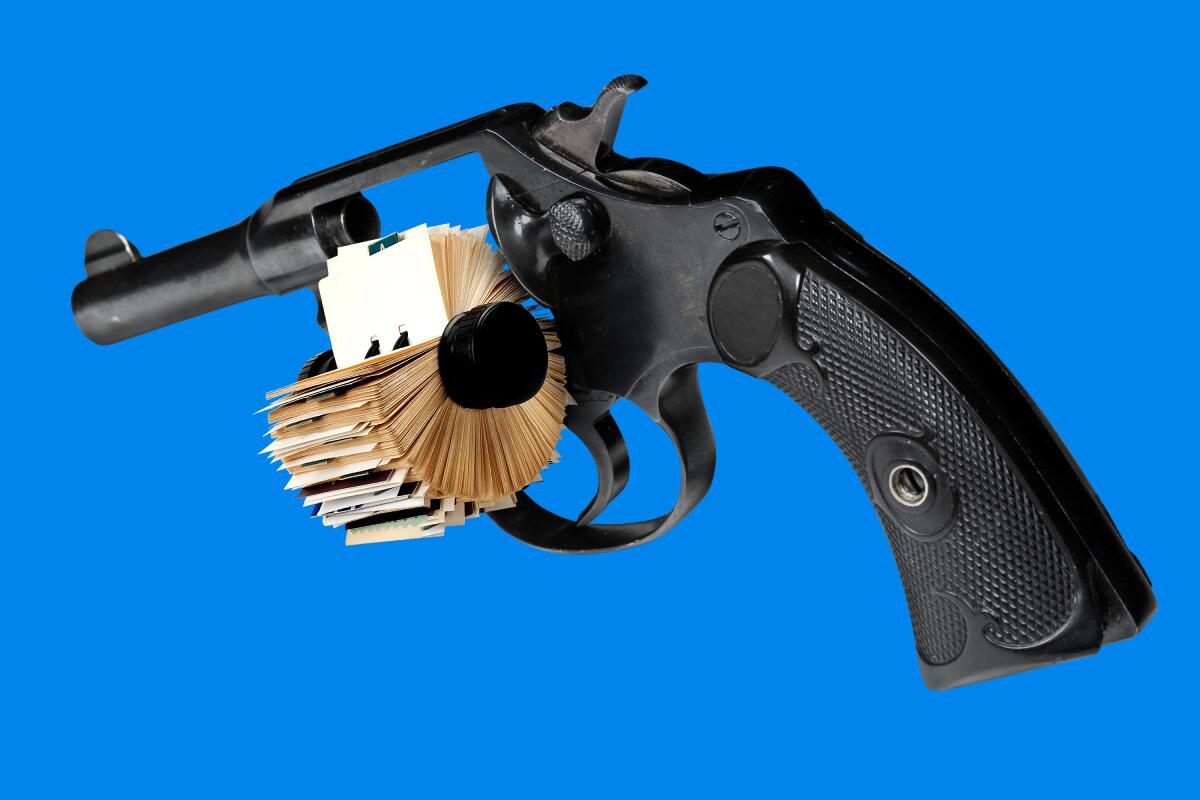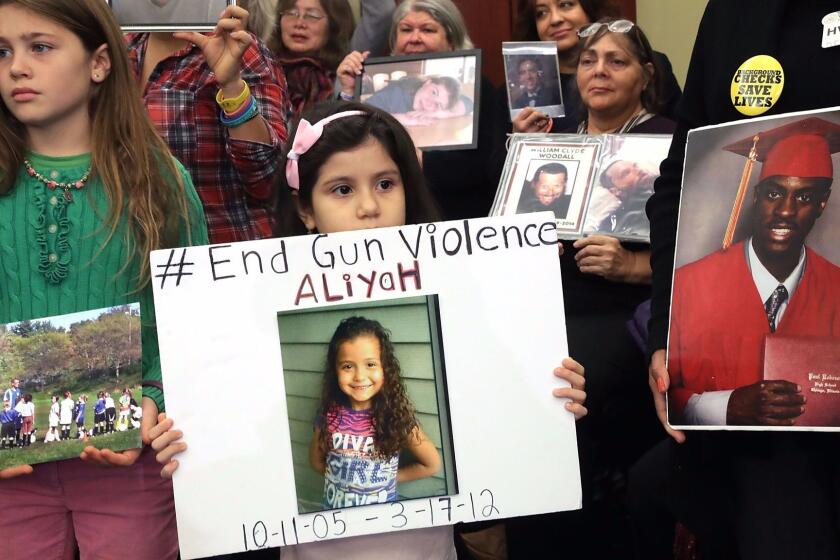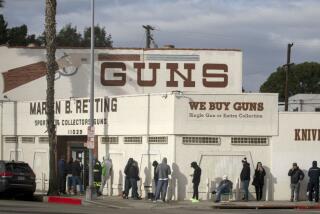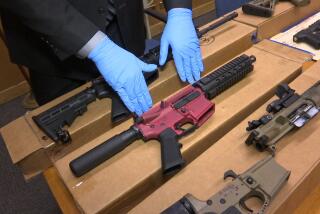The GOP and the NRA want to stop gun violence research. California is a target

WASHINGTON — Last summer, the California Department of Justice accidentally published the personal information of roughly 192,000 firearm owners to the open internet. Gun owners protested; Atty. Gen. Rob Bonta apologized and launched an investigation.
But perhaps the most surprising aspect of the leak is that the data existed in the first place.
California is the epicenter of American gun violence research, largely because it maintains an extensive repository of firearms data and, unlike other states, has historically made much of the data available to scientists studying the root causes of gun deaths.
A lawsuit brought by gun-rights activists now threatens that longstanding data infrastructure. And although the federal government began funding gun-violence research again in 2019, following a two-decades-long drought, that funding is under threat from House Republicans, who have vowed to kill it.
Scientists have only begun to understand the factors that put Americans at risk of firearm injury. The double blow of ending federal funding and cutting off researchers’ access to California’s data could set the field back years.
Researchers would have to scrape by on grants from private entities and limited state funding. Academics might move away from the work, said Garen Wintemute, who directs a gun violence research center at UC Davis. The number of studies on guns would decline. Scientists’ understanding of the violence that kills tens of thousands of Americans each year would stagnate.
The records made public last June were gathered as part of an effort to quantify and publicize how many Californians were seeking to carry a concealed firearm in public. The state also keeps meticulous data regarding every firearm transaction — every sale, every transfer. Under California law, even private gun transactions must happen through a retailer. The state maintains a single file that records every legal handgun transfer since 1996 and every rifle and shotgun transfer since 2014. No other state has anything like it.
“The capacity to answer... questions with that data in California is really meaningful for the rest of the country,” said Cassandra Crifasi, a firearm researcher at Johns Hopkins University. “Some of the work that [California researchers are doing]… you literally could not do anywhere else, because of their decision to prioritize this information.”
No state has had a bigger impact on the direction of the United States than California, a prolific incubator and exporter of outside-the-box policies and ideas. This occasional series examines what that has meant for the state and the country, and how far Washington is willing to go to spread California’s agenda as the state’s own struggles threaten its standing as the nation’s think tank.
For decades, senior academics outside of California actively discouraged young researchers from studying gun violence, Crifasi said. Megan Ranney, now dean of the Yale School of Public Health, was told at the start of her career not to study guns. She was an emergency physician at the time, and a series of cases rattled her: a domestic violence victim shot by her partner; a young man whom Ranney’s team saved from a first gunshot wound but whom they couldn’t save from a second; a young man who took his own life with one of his parents’ firearms. The incidents stuck with Ranney, but mentors across the country warned her that investigating the issue was “too politically fraught.”
Scientists elsewhere envied the Golden State, but lacked the funding to carry out the research that was possible here.
That changed in 2019, when Congress authorized new federal funds for gun violence research for the first time since 1996. With the new money — $25 million a year — academics everywhere could finally start to do what Californian researchers have been doing since before the turn of the century.
The field has exploded. Seven years ago, almost every scientist studying firearm injury prevention — a little more than a dozen people — met in a single room, Ranney told The Times. Last year, gun violence researchers held their first ever conference dedicated solely to firearm injury prevention and treatment. More than 500 researchers gathered in Washington, D.C., to discuss research-backed methods for reducing firearm violence.
All of that new science is now at risk. In Washington, where Republicans now control the House of Representatives, partisan disagreements could trigger a government shutdown at the end of September, and lawmakers may need to scramble to reach a deal. President Biden and Senate Democrats might not make a point to defend a $25-million line within a $1.7-trillion spending bill.
“It’s going to be a fierce battle,” said Mark Rosenberg, a former Centers for Disease Control and Prevention official who oversaw early efforts to research gun violence in the 1990s. He stressed that Rep. Kay Granger (R-Texas), the powerful appropriations chair in the House, “has said she wants to get rid of the little bit of funding that is there.”
Granger’s office did not respond to a request for comment. But House Republicans confirmed their intention to rid this year’s appropriations bills of funding for gun-violence prevention. Their markup proposal for next year’s Labor, Health and Human Services and Education bill scraps the funding, referring to it as “controversial.”
In October, the California gun-rights activists challenging the state law that requires the state to share gun transaction data with researchers won an injunction blocking the state from enforcing the law while their case unfolds. Since then, gun-violence researchers have been unable to access up-to-date information about California firearm transactions.
“There’s been so little research done,” Garen J.
That’s a big problem, Wintemute said. Scientists regularly use California’s data to assemble cohorts of firearm purchasers and follow them forward in time. At one point, Wintemute’s team tracked two groups: Californians convicted of violent misdemeanors who tried to purchase a firearm before the state prohibited that demographic from buying guns, and a group with the same conviction who tried to buy firearms after the policy changed. The researchers found that the second group, which was not allowed to purchase the firearm, had a 25% lower rate of subsequent arrest.
That finding suggested that California’s decision to block people convicted of violent misdemeanors from owning guns made them less likely to commit violent crimes in the future. In a country where the vast majority of gun laws are not supported by evidence, such findings are rare.
Firearm industry interests, who consistently oppose efforts to provide academics with data on gun violence, know that their political efforts hinder potentially useful research. Laws that block data access “prevent researchers from conducting accurate studies with the number and distribution of firearms as a variable,” Josh Savani, the National Rifle Assn.’s director of research and information, wrote in a 2021 internal report.
Only a small handful of gun safety policies are supported by strong evidence, according to Andrew Morral, who runs a team at the Rand Corp. that tracks the current state of gun research. Morral’s group has identified supportive evidence that more restrictive concealed-carry laws reduce violent crime, for example, but inconclusive evidence that such laws affect suicide rates. Moderate evidence suggests that minimum age requirements prevent suicide, but only limited evidence supports the idea that assault weapons bans prevent mass shootings — despite the fact that many mass shootings involve assault weapons and high-capacity magazines.
Over the last 10 years, influenza has claimed on average just short of 33,000 lives a year in the United States.
“The quality of research in this area has been uneven,” Morral said. “As a result, if you are really dedicated to a particular perspective, you can cherry-pick research that supports your perspective.”
Researchers said they hope other states embrace California’s approach to data access, but note that the state’s informational infrastructure is the product of decades of work. How the lawsuit over data sharing is resolved could set the tone for the rest of the country, especially other states considering similar policies.
Some jurisdictions have taken small steps toward replicating California’s data infrastructure, researchers noted. Michigan will soon expand access to data for extreme-risk protection orders, said April Zeoli, a gun researcher at the University of Michigan. Cities such as Chicago have made strides to gather and analyze data on gun violence.
But on a national level, Ranney stressed, data are sparse: Academics lack data on the secondary effects of a bullet being fired — in other words, the damage done to family and friends of those harmed by gun violence, alongside witnesses. They lack much data on the best ways for researchers to partner with law enforcement, and on how to identify the people who are most at risk. They’re still trying to more fully understand how different demographic groups experience gun violence differently.
Zeoli said that her state’s policies for sharing data are vastly different from California’s. “California is so, so, unique,” she said. “I don’t know that any state is going to or wants to have the data systems around firearms that California is able to have.”
If courts block continued data-sharing, California could still aid gun-violence researchers by providing funding if — or when — federal money dries up. California’s research push flourished during the 23-year funding freeze because the state has a tendency to take the lead on issues when other states cannot, Wintemute said.
“The absence of funding elsewhere made it, on balance, easier to get funding here in California,” he said. “As governors of other states run for higher office on very conservative platforms, this state will probably say: ‘Not here. We are different.’ ”
More to Read
Get the L.A. Times Politics newsletter
Deeply reported insights into legislation, politics and policy from Sacramento, Washington and beyond. In your inbox three times per week.
You may occasionally receive promotional content from the Los Angeles Times.













